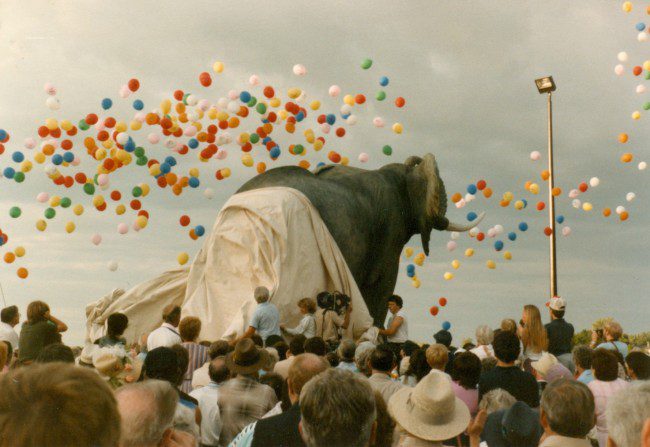Inducted 2006
The history of the Jumbo statue in St. Thomas begins with the history of Jumbo, the African elephant. Jumbo was the star of the Barnum and Bailey circus and P.T. Barnum’s greatest coup. Jumbo is reputed to be the largest ever in captivity and is probably the best known non-human that ever lived. His name is a household word in many countries of the world and is used to describe everything from ice cream cones to jet aircraft.
On his second visit to St. Thomas on September 15, 1885, Jumbo had a fatal collision with a Grand Trunk locomotive. The Jumbo statue commemorates the one hundredth anniversary of this fateful event. The monument was unveiled June 29th, 1985 during a festive five day event called “Jumbo Days.”
The statue was designed and constructed by Winston Bronnum in Sussex, New Brunswick. It is made of concrete with steel reinforcing rods. The body is hollow and the walls are about seven inches thick. The legs are solid concrete and steel. The skin texture was achieved by trowelling on three-quarters of an inch of coloured cement and sand plaster. The statue with its six inch base weighs thirty-eight tons. The base pedestal was constructed on the site and weighs over one hundred tons.
In order to clear the bridges on the 1,070 mile trip down the Trans-Canada Highway, the lower part of the legs and the six inch base were poured separately from the upper part of the legs and body. The two sections were later joined at the site and held together by four large concrete pegs which were attached to the lower leg sections and inserted into the upper sections. Transportation was effected by two large tractor-trailer trucks. The journey from Sussex to St. Thomas and the assembly at the site captured the attention of media throughout North America.
The project was funded with contributions from citizens, corporations and organizations of St. Thomas and Elgin County, along with the St. Thomas Kiwanis Club raising over $50,000 towards the project. The statue stands on land provided by the City of St. Thomas.


